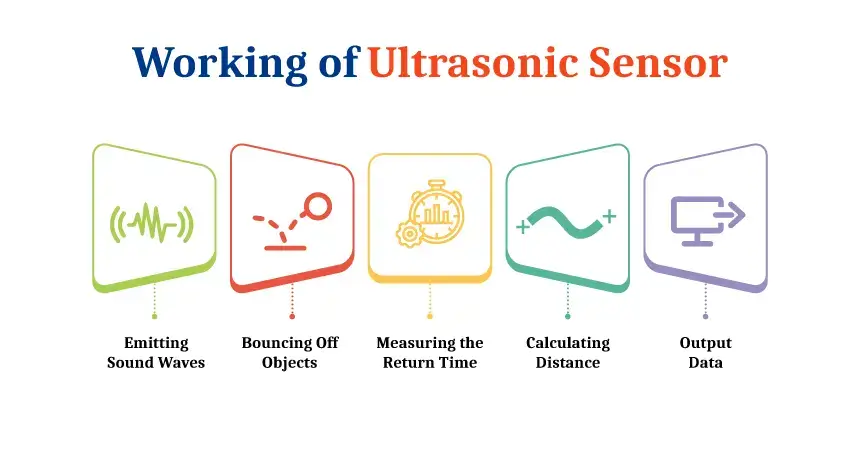

Ultrasonic detection is one of the greatest ways of reliably sensing levels and determining proximity. Since they have been in use for many years, ultrasonic sensors have a significant portion of the sensing market. These sensors play a crucial role in countless applications, from industrial automation to robotics and automotive safety systems. In this brief overview, we’ll delve into the mechanics of ultrasonic sensor working. The use of ultrasonic sensors in various fields, such as drones and electric cars, is growing as the automation sector develops. This blog provides a deep knowledge of what is ultrasonic sensor and how it works.
Ultrasonic sensors are electronic devices that determine a target’s distance. They work by emitting ultrasonic sound waves and converting those waves into electrical signals. Furthermore, ultrasonic travel at a faster rate than audible sounds. Therefore, ultrasonic sensor work involves sound waves to find the distance to an item. A transducer is also there to transmit and receive ultrasonic pulses. These pulses help to communicate information about an object within range. Further, this detail can be applied in various applications including industrial. Let’s discuss in detail how ultrasonic sensor works.
Ultrasonic sensors operate by emitting sound waves at frequencies that are too high for humans to hear. The sensor’s transducer serves as a microphone to receive and transmit ultrasonic sound. They also use a single transducer to send and receive pulses. Further, the sensor measures the total time taken to deliver and receive an ultrasonic pulse and calculates the target’s distance.
The working principle of an ultrasonic sensor revolves around the emission and reception of high-frequency sound waves. These waves range from 20 kHz which is beyond the range of human hearing. Here’s a simplified explanation of ultrasonic sensor operation:

The above principle determines the ultrasonic sensor working. Now, let’s discuss the application areas of these sensors.
Ultrasonic sensors are used in many areas of engineering. In automation, robotics, and instrumentation, “no-contact” distance measuring is highly helpful. Below are the common uses and functions of ultrasonic sensors:
Other Common Applications of Ultrasonic Sensors Include:
The sensor (movement of a manipulator’s arm or mobile robot) may have an impact on how measurements are captured. Thus, the displacement must be evaluated to do precise measurements or high-speed robot displacement.
Moving air in the atmosphere messes with the measurement and may limit the range. Noise, for example, can disrupt work and cause detection errors.
Sound-absorbing materials are invisible to them. Thus, objects with angled surfaces deflect the echo away from the sensor or permeable targets. For example, sponges, foam, and soft garments may make it more difficult to detect them. They absorb most of the reflected ultrasonic energy and disrupt ultrasonic sensor working.
Temperature changes strongly affect ultrasonic sensors. However, using models with temperature compensation will help you avoid this issue.
A piece of technology that makes use of ultrasonic sound waves is an ultrasonic sensor. The ultrasonic sensor work involves the detection of the distance to a target item. The sensor evaluates how long it takes for the sound to travel from the transmitter’s release to the receiver. This helps to find out how far away the object is from it. They have many uses across various industries. However, they also have a few limitations as discussed in the blog.
Ans. To identify things nearby, ultrasonic sensors use sound waves above the 20 kHz range.
Ans. The 4 pins of the ultrasonic sensor are HC-SR04: VCC (Power), Trig (Trigger), Echo (Receive), and GND (Ground).
About The Author:
The IoT Academy as a reputed ed-tech training institute is imparting online / Offline training in emerging technologies such as Data Science, Machine Learning, IoT, Deep Learning, and more. We believe in making revolutionary attempt in changing the course of making online education accessible and dynamic.

Digital Marketing Course
₹ 9,999/-Included 18% GST
Buy Course₹ 29,999/-Included 18% GST
Buy Course